Grasserie
This is kinda gross. It’s interesting if you raise silkworms, but if you’re easily squicked out, you might not want to click.
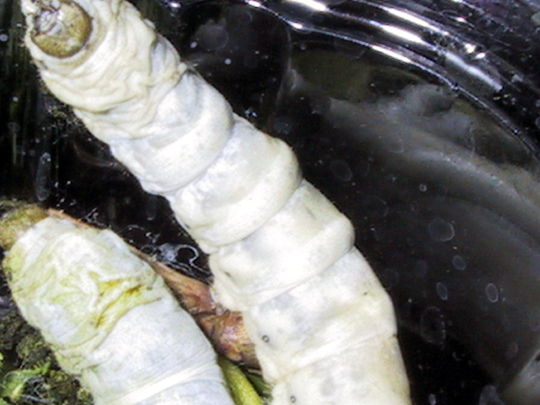
Grasserie is caused by a virus called Borrelina. It is infectious through contact with the spores, and it can be spread through the skin of the silkworms and through ingestion of contaminated food. I don’t know where it came from, or if this disease has other insect vectors here in the US.
The first sign is that the worm looks a lot more plump than it should. When it’s stretched out, it’s kind of hard to tell – but the segments don’t look right.
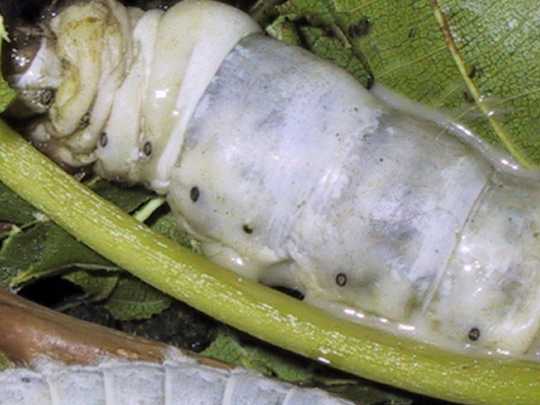
When the worm contracts, the over-fullness of the segments is distinct. They look like little sickly Michelin Men. They also become very fragile – the skin breaks easily, and oozes infectious milky liquid. It reminds me a lot of proofing yeast in water.

The worms start to get dark. Some of them will get what look like hernias, where the green mulberry inside pushes out toward one side. They get listless, and stop eating.
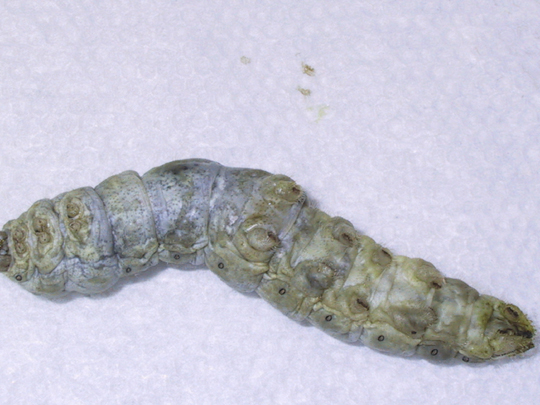
They eventually stop moving, although it takes them a while to die.
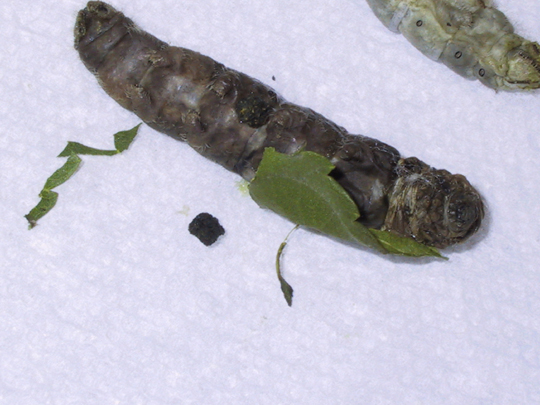
Once dead, within a few hours they are black and putrefying. You have to be very careful picking them up, or they bust open and ooze guts. It’s really gross.
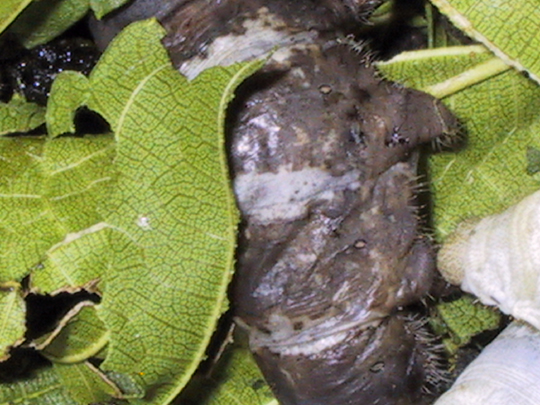
This is about a day later. I had to pick this one up with a spoon.
I’ve been managing the disease with several methods:
I immediately discard any worms that start to show symptoms, before they can ooze on the leaves or other worms.
I wash the trays, and then disinfect them with bleach water; I wash the netting between tray cleanings with bleach.
I net the worms up daily, or even twice daily – the sick ones don’t climb upward, so it separates the well from the ill.
I wash my hands and spritz them with specially denatured high-proof alcohol any time I have to handle infected worms or trays.
It seems like the management techniques have been relatively effective, as I’m having fewer new infections. I’m still hoping to get several hundred good cocoons from this batch, but I’ve probably lost between a third and half.

Gross yes, but fascinating and informative. Thanks for sharing – it’s good to have pictorial information about what can go wrong as well as when things are perfect.
Despite not having begun to play with silkworms yet, I still find this utterly fascinating – and a great preparation for when I do manage to do so.
Wow, stuff like that fascinates me. It’s gross, of course. Thanks for the info!
So sorry to hear of your blight–I lost some lunas when the larget of the larvae cleared his guts before going pupal and contaminated some others, a few of which died.
oh.
those poor little worms.
how tragic.
good luck with fighting the infection!
Gross, but fascinating.
We use a bacteria called Bacillus Thuringiensis in the garden on catterpillars. It works pretty much like this on the loopers and corn earworms.
Very informative on a lesser known aspect of insect rearing. Thanks for posting this and the associated images.
Yup. BT is like Caterpillar Plague – it’s horrible if you get it on the stuff the silkworms eat, or have cross-contamination by the hands, etc. I can’t use it in the yard, because of all the different things I feed to the various species.
I had some polyphemus that did similar – whatever is making them sick with that particular disease, makes them want to go to the highest point they can reach, hang by their back feet, and barf on *everything*. Guess the virus/bacterium/whatever is running their brains at that point.
Aweeee… that is so sad. 🙁 I hope you don’t lose too many.
How sad!
POOR fellahs! that sounds horrible! Nobunny should ide like that. 🙁
Oh and please don’t think I’m forgetting about you I’m working day and night to get my tattoo shop ready for inspection in early Aug and once that’s sorted out my brain will stop hurting and I’ll be free to think again. It’s too bad you didn’t grab me right when I wanted you to remind me. I would have had a couple days in there to get a little sumtin sumtin going. But I will and I think I can make it really lovely for you so please don’t lose faith in me. I LOVE what you do and want to do this for sure. 🙂
Hee… I *totally* understand about the schedule thing – if I hadn’t been brain-dead myself when it was time to grab you, I would have.
I’ll just bug you, persistently, later on!
Persistent is the way to go with a busy gal like me. Ideas are still roaming around in my little brain that I think you’ll really like. 🙂 And pretty soon I’ll have a little a time to give you pretty soon if this shop passes inspection.
Oh how sad! That looks really painful! And you’re right it’s utterly gross! What a horrible disease!
Eww. This is the disease that took out the majority of my caterpillars last year. I tried to sanitize the way you described but I didn’t always have enough time, and as a result I lost most of the cats I was raising. It affected everything from my lunas to the silkworms, although none of the butterfly cats I was raising got it. I’m not sure if they were just kept more efficiently separate or if they weren’t as susceptible.
This year I knew my summer would be hectic so I just didn’t take on the responsibility (beyond a few odds and ends caterpillars my daughter carted in from the garden). I’m hoping to get back into it next year.
Just saw this, I’m so sorry to hear about the problems! I hope you were able to save as many as you thought you’d be able to save!
Wow…I feel a mixture of yuck and fascination. I hope the others make it ok.
What got you interested in these guys in the first place?
I was fascinated with moths and butterflies as a child; I learned to weave during college, and then figured out that I could actually raise silkworms back in 2001.
I enjoyed your responses to my post on Punk Knitters and came to check out your journal.
I hate to be a geeky annoying person, but I work with insect viruses, and I haven’t heard of “Borrelina virus”. At least, it doesn’t seem to show up as a term after the 1960s. Also viruses don’t sporulate per se, although there are a couple of insect viruses with a VERY cool means of maintaining themselves in the environment. I just kind of wonder if maybe you meant bacteria rather than virus?
Also, I wanted to say that I have online access to a lot of journals though my university’s library. I don’t know your interest in or access to some of the sciency stuff, but I’d be very happy to download and send you articles that you’d like to read but can’t access.
I’d love to read more about silkworms, if you know of additional sources. I’m not savvy enough to understand some of the highly technical stuff, but the practical-level information is always welcome.
The place I found the “Borrelina” information is an Indian sericultural text – it’s recent, but they often have a lot of mixed/outdated information. I’ve had difficulty finding good recent information in English, because most of the serious scientific adventures in sericulture are taking place in non-English speaking nations.
Being a geek, I did some more poking around. A few really old texts suggests that what you’re dealing with is a virus usually refered to as a baculovirus. I’m not suprised, since your photos and descriptions are consistent with baculo infections.
You might be interested to know that people like to use baculoviruses as genetic vectors for making proteins in insect cells. I could go on and on about this, but it doesn’t make a lot of difference to silk production!
I’m not sure about what I can find in general sericulture, but I’ll nose around a little bit. There are books on baculviruses, but not books you’d want to read! Likewise I’m sure a 2005 review on the “genetics and genomics” of the silkworm would only be good bedtime reading in that it’d put you to sleep.
Nice to touch base, though, and if you do find you ever want to talk insect virology, drop me an email (boulderbird@hotmail.com).
silkworms as feeders
My concern is the possibilty of an infected worm not showing symptoms and being fed to one of my leos. A forum that i visit daily mentioned beardies that had been eating silkies were showing up sick with no explaination by vets as what it could be.
How prevelant is this virus in silkie breeders and should they no longer be a part of my leos diet.
Re: silkworms as feeders
I’ve never had a lizard pet. I’m really not qualified to comment on that aspect of it.
I can tell you that silkworms get a variety of diseases, from viruses to parasites – but, so do any live insects. I would guess that making sure to use healthy feeders of whatever type would be the best solution.